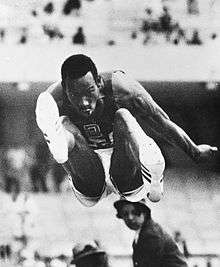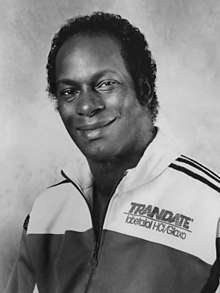Bob Beamon
|
Robert "Bob" Beamon, 1992 | |||||||||||||||||
| Personal information | |||||||||||||||||
|---|---|---|---|---|---|---|---|---|---|---|---|---|---|---|---|---|---|
| Nationality | United States | ||||||||||||||||
| Born |
August 29, 1946 South Jamaica, Queens, New York | ||||||||||||||||
| Height | 6 ft 3 in (191 cm) | ||||||||||||||||
| Weight | 150 lb (68 kg) | ||||||||||||||||
| Sport | |||||||||||||||||
| Sport | Track and field | ||||||||||||||||
| Event(s) | Long jump | ||||||||||||||||
| College team | UTEP Miners | ||||||||||||||||
Medal record
| |||||||||||||||||
Robert Beamon (born August 29, 1946) is an American former track and field athlete, best known for his world record in the long jump at the Mexico City Olympics in 1968. He broke the existing record by a margin of 55 cm (21¾ in.) and his world record stood for almost 23 years until it was broken in 1991 by Mike Powell. Beamon's Olympic record stands to this day.
Early life
Robert Beamon was born in South Jamaica, Queens, New York.
When he was attending Jamaica High School he was discovered by Larry Ellis, a renowned track coach. Beamon later became part of the All-American track and field team. Beamon would begin his college career at North Carolina Agricultural and Technical State University, to be close to his ill grandmother.[1] After her death, he would transfer to the University of Texas at El Paso where he received a track and field scholarship.[2]
In 1965 Beamon set a national high school triple jump record and was 2nd in the nation in the long jump. In 1967 he won the AAU indoor title and earned a silver medal at the Pan American Games, both in the long jump.[3]
Beamon was suspended from the University of Texas at El Paso, for refusing to compete against Brigham Young University, alleging it had racist policies. This left him without a coach, and fellow Olympian Ralph Boston began to coach him unofficially.[4]
1968 Summer Olympics

Beamon entered the 1968 Summer Olympics in Mexico City as the favorite to win the gold medal, having won 22 of the 23 meets he had competed in that year, including a career best of 8.33 m (equivalent to 27 ft. 4 in.) and a world's best of 8.39 m (27 ft. 6½ in.) that was ineligible for the record books due to excessive wind assistance. That year he won the AAU and NCAA indoor long jump and triple jump titles, as well as the AAU outdoor long jump title.[3] He came close to missing the Olympic final, overstepping on his first two attempts in qualifying. With only one chance left, Beamon re-measured his approach run from a spot in front of the board and made a fair jump that advanced him to the final. There he faced the two previous gold-medal winners, American Ralph Boston (1960) and Lynn Davies of Great Britain (1964), and twice bronze medallist Igor Ter-Ovanesyan of the Soviet Union.[5]

On October 18, Beamon set a world record for the long jump with a first jump of 8.90 m (29 ft. 2½ in.), bettering the existing record by 55 cm (21¾ in.). When the announcer called out the distance for the jump, Beamon – unfamiliar with metric measurements – still did not realize what he had done.[6] When his teammate and coach Ralph Boston told him that he had broken the world record by nearly 2 feet, his legs gave way and an astonished and overwhelmed Beamon suffered a brief cataplexy attack brought on by the emotional shock,[7] and collapsed to his knees, his body unable to support itself, placing his hands over his face. In one of the more endearing images of the Games, his competitors then helped him to his feet.[8] The defending Olympic champion Lynn Davies told Beamon, "You have destroyed this event," and in sports jargon, a new adjective – Beamonesque – came into use to describe spectacular feats.[9]
Prior to Beamon's jump, the world record had been broken thirteen times since 1901, with an average increase of 6 cm (2½ in.) and the largest increase being 15 cm (6 in.). His world record stood for 23 years until it was finally broken in 1991 when Mike Powell jumped 8.95 m (29 ft. 4⅜ in.) at the World Championships in Tokyo, but Beamon's jump is still the Olympic record and 49 years later remains the second longest wind legal jump in history. One journalist called Beamon "the man who saw lightning."[10] Sports journalist Dick Schaap wrote a book about the leap, The Perfect Jump.
Beamon landed his jump near the far end of the sand pit but the optical device which had been installed to measure jump distances was not designed to measure a jump of such length. This forced the officials to measure the jump manually which added to the jump's aura.
Beamon's world-record jump was named by Sports Illustrated magazine as one of the five greatest sports moments of the 20th century.
Later life
Shortly after the Mexico City Olympics, Beamon was drafted by the Phoenix Suns in the 15th round of the 1969 NBA draft but never played in an NBA game.[11] In 1972 he graduated from Adelphi University with a degree in sociology.[12]
Beamon has worked in a variety of roles to promote youth athleticism, including collaborations with former California governor Arnold Schwarzenegger and Beamon's work at the athletic programs of several universities. He is a graphic artist with work exhibited by the Art of the Olympians (AOTO), and was the former chief executive of the Art of the Olympians Museum in Fort Myers, Florida.
Honors
Beamon is in the National Track and Field Hall of Fame, and when the United States Olympic Hall of Fame started to induct athletes in 1983, Beamon was one of the first inductees.[12][13]
References
- ↑ Schwartz, Larry. "Beamon made sport's greatest leap". ESPN.com. ESPN. Retrieved 6 July 2016.
- ↑ Williams, Lena. "TRACK AND FIELD; Soothing an Old Ache", The New York Times, January 1, 2000. Accessed November 7, 2007.
- 1 2 Bob Beamon Archived 2015-06-30 at the Wayback Machine.. sports-reference.com
- ↑ Bob Beamon Biography at thehistorymakers.com
- ↑ Bagchi, Rob (November 23, 2011). "50 stunning Olympic moments No2: Bob Beamon's great leap forward". The Guardian.
- ↑ "CCTV International". Cctv.com. 2008-10-15. Retrieved 2011-10-29.
- ↑ Redgrave, Steve (13 October 2011). Great Olympic Moments. Headline. pp. 16–. ISBN 978-0-7553-6339-1.
- ↑ "Encyclopædia Britannica Article on Bob Beamon". Britannica.com. Retrieved 2011-10-29.
- ↑ IOC Athlete Profile, – "His achievement inspired a new word in the English language: Beamonesque, meaning an athletic feat so dramatically superior to previous feats that it overwhelms the imagination."
- ↑ The man who saw lightning, rompedas, December 21, 2009.
- ↑ Draft Oddities, nba.com
- 1 2 "The HistoryMakers". The HistoryMakers. Retrieved 2015-10-21.
- ↑ Notable US Olympic Hall of Fame inductees. NBC Sports. Retrieved on 2017-07-21.
Further reading
- Beamon, Bob, and Rhonda Beamon. (1999). The Man Who Could Fly: The Bob Beamon Story. Columbus, MS: Genesis Press. ISBN 1-885478-89-5.
- Schaap, Dick. (1976). The Perfect Jump. New York, NY: New American Library.
External links
| Wikimedia Commons has media related to Bob Beamon. |
| Records | ||
|---|---|---|
| Preceded by |
Men's Long Jump World Record Holder October 18, 1968 – August 30, 1991 |
Succeeded by |
| Awards | ||
| Preceded by |
Track & Field Athlete of the Year 1968 |
Succeeded by |
| Achievements | ||
| Preceded by |
Men's Long Jump Best Year Performance 1968 |
Succeeded by |
